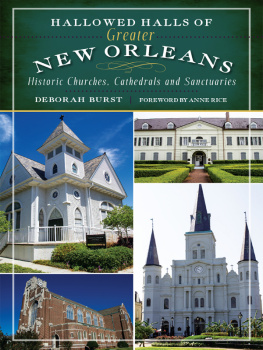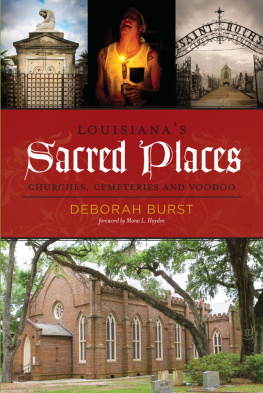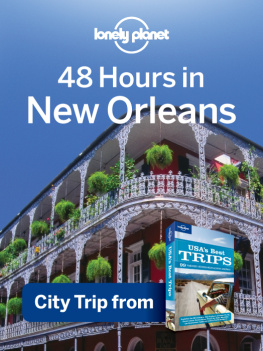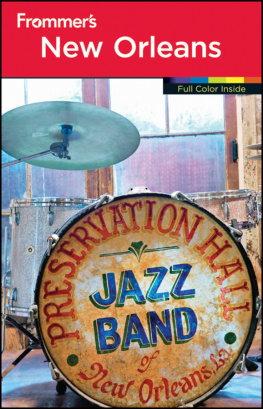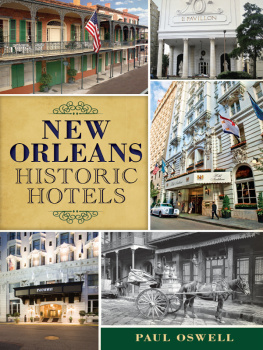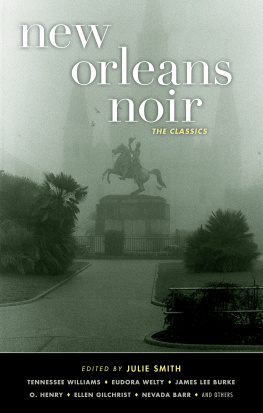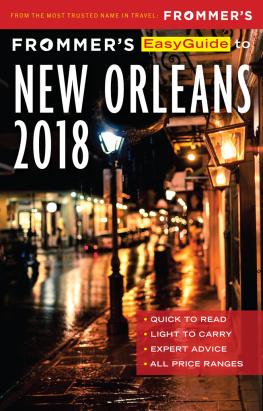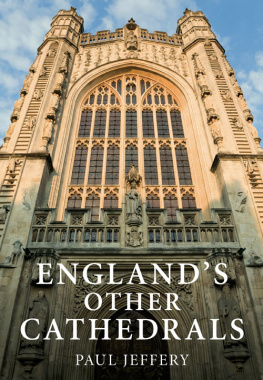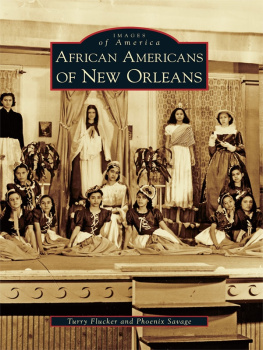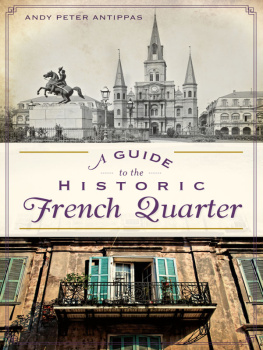
Published by The History Press
Charleston, SC 29403
www.historypress.net
Copyright 2013 by Deborah Burst
All rights reserved
All photos courtesy of the author unless otherwise noted.
First published 2013
e-book edition 2013
Manufactured in the United States
ISBN 978.1.62584.003.5
Library of Congress CIP data applied for.
print edition ISBN 978.1.60949.905.1
Notice: The information in this book is true and complete to the best of our knowledge. It is offered without guarantee on the part of the author or The History Press. The author and The History Press disclaim all liability in connection with the use of this book.
All rights reserved. No part of this book may be reproduced or transmitted in any form whatsoever without prior written permission from the publisher except in the case of brief quotations embodied in critical articles and reviews.
For my dad and brotherwe miss you!
CONTENTS
FOREWORD
New Orleans is the city that love never forgot and that never forgets to love. When you move out into the world, you experience such a different approach to things. The tolerance in New Orleans is something rare, the love of family is rare, and the co-existence of ardent faith with the Mardi Gras Dionysian spirit is rare and special and priceless.
Im glad progress doesnt move very fast in New Orleansthats why we still have so many beautiful homes and buildings. I left too abruptly at the age of sixteen; my life had been interrupted. When I went back after thirty-eight years, I picked up the thread, and I enjoyed that very much. I think there are a lot of people who dont have that connection to where they are born. Ive always been in love with my hometownjust in love with it enough to describe it in book after book after book and keep going back to its atmosphere and ambiance as a source of inspiration.
The baroque beauty of St. Alphonsus, its profoundly Italian feeling and its exquisite excess of ornament will forever influence my life and my writing. I grew to love the sensuality and evocative quality of its heavily figurative artthe story told in the stained-glass windows and the Stations of the Cross and the stories represented by so many statues of the saints. I loved the giant crucifix and often studied it as I prayed. The Mother of Perpetual Help Altar was a favorite stop for me to pray and light a candle. The day I learned my mother died, I went to that altar and knelt there and talked to the Blessed Mother.
And the murals on the ceilingI remember the whole spreadthe lovely baroque colors, the blue skies, etc. What sank deep into me was the Italian Baroque style of art; it was tender but realistic. All the details of the church mattered, from the dark pews to the detailed dark wooden confessional booths in the rear.
We loved to go to pay a visit to the Blessed Sacrament, my mother and I, to kneel in prayer at the Communion rail or in one of the pews. The large, cool nave always gave me a profound sense of sacred space, a place in which I could easily turn my thoughts to God, to the eternal, to the meaning of life. I remember attending a 5:30 a.m. Mass with my mother once in the summer. We took the Jackson bus from near our house on St. Charles, and I loved the stillness of that hour.
The history of St. Alphonsus is very important to me. I hope and pray that my descriptions of St. Alphonsus and St. Marys in my novels represented some little memorial to the beauty and spirituality I experienced in these churches growing up. In my novel The Witching Hour, Michael Curry, the hero, visits St. Alphonsus, and it means a lot to him. He and Rowan Mayfair are later married in St. Marys. Earlier in the novel, I described the old school on St. Andrew and Constance. The parish is in my blood.
I have not been in St. Alphonsus in ten years, but when I return to New Orleans again, I will definitely visit. I will visit St. Marys and St. Louis Cathedral as well.
Catholic churches, in their monumental beauty, belong to all of us, and they transcend the political policies of any one parish, diocese or country. I believe our faith in God transcends whatever differences we might have with one another as Protestants or Catholics or even Buddhists or Hindus. We must learn to love one another, respect the journey of each and trust in Gods will for his children of all faiths.
Anne Rice
ACKNOWLEDGEMENTS
Although I have written more than one thousand published articles and published twice as many photographs, this book, my first, was a new adventure, to say the least. A tedious yet fulfilling project, I met so many intriguing peoplemany from the eighteenth and nineteenth centuries. Oftentimes, sitting in the library or on my back deck, I would drift off into this new world, enamored with the people and architecture. On my photo shoots, I listened to the quiet echoes of my camera shutter, and with every picture, I wanted more. I wanted to feel the euphoria of that first Mass, a bride walking down the aisle, a young communicant kneeling at the altar, the joyful singing of Christmas carols and families dressed in their Sunday best on Easter Sunday.
There were many late nights and tears of frustration. But it was when I hit the lowest of the lows that I discovered the miracles of a broken heartmuch like Irvin Mayfield and his All the Saints concert at Christ Church Cathedral. Trips to my hometown of New Orleans saved me from the lonely abyss of late-night writing marathons. New Orleans is a city with so much life and so many secrets, and the history can swallow you whole. Visits to St. Louis Cathedral are always a treasure, but turning the corner of Charters and Ursuline was probably one of the most emotional moments.
Walking through the Old Ursuline Convent Museum, you could feel the presence of extraordinary history. In the Cherished Revivals chapter, I share its architectural history and the history of the Ursuline nuns, who not only established one of the first hospitals in New Orleans but also treated malaria and yellow fever in slave populations when it was not politically correct. They cared for both British and American soldiers wounded in the Revolutionary War, and Sister Francis Xavier became the first female pharmacist in the New World. These women established the first free school in New Orleans and classes for female African American slaves, free women of color and Native Americans.
There was also Pope John Paul IIs visit to New Orleans and learning that our Aunt Rita had actually touched his hand during his visit to St. Louis Cathedral. The same Pope canonized Katharine Drexel, featured in my Blessed SacramentSt. Joan of Arc Church chapter. She was a major force in educating African Americans in New Orleans, establishing several elementary schools, Xavier University Preparatory High School and Xavier University of Louisiana. It is the historyboth past and presentthat brings life to these hallowed halls.
This work, like any lifelong endeavor, is a product of many individuals. As always, my husband, Michael, remained my rock, my voice of reason. He delivered many meals to a frayed, crazed woman bewitched by the computer. To my editor, Christen Thompson, an angel on earth with the patience of a saint, I knew I was in good hands from our first meeting at Brennans Restaurant. Tremendous thanks to the Queen of New Orleans, the incomparable Anne Rice, for her repeated words of encouragement, multiple interviews and taking the time from writing her own book, The Wolves of Midwinter, to gift me with a foreword. I would be lost without my writing friends. Thanks to Pamela Ewen Lott and Mona Hayden, my longtime cheerleaders, for cheering me on to write this book; Mark Newman, best friend and proofreader, for keeping me sane in an insane world; and Lee Froehlich, my mentor/proofreader, for inking my drafts with reckless abandonment. To all the people who took the time to share their memories and answer endless questions, I salute you. Thanks to my mother, Helen, who loves reading my work over and over, and to my sisters Twana and Misha, who continue to sing my praises in this late-life career. The loves of my life, my children, Julie and Jared, sent hundreds of text messages encouraging me to never give up. My dog, Pepper, a feisty young lass, helped melt away the terrors of writers block. Lastly, thanks to my late father and brother, both of whom were taken away from this world much too early. While my father preached that hard work would bring great rewards, my brother taught me to live life like theres no tomorrow. This book is for you guys!
Next page
